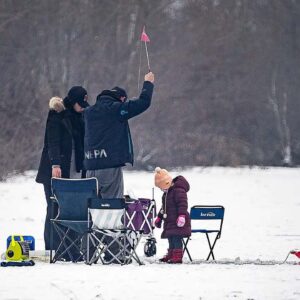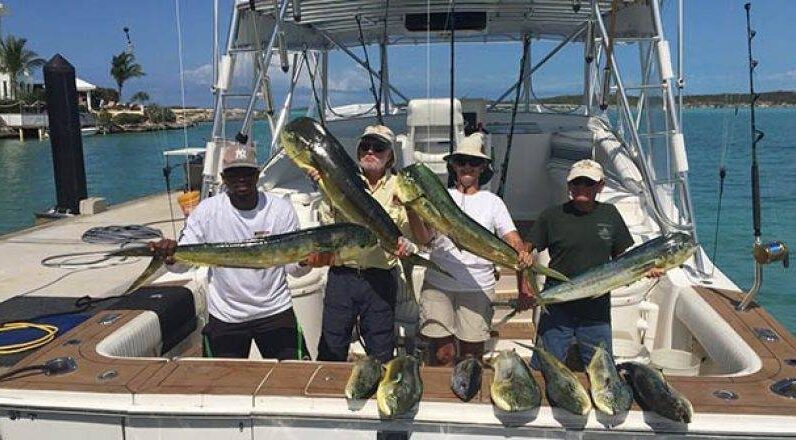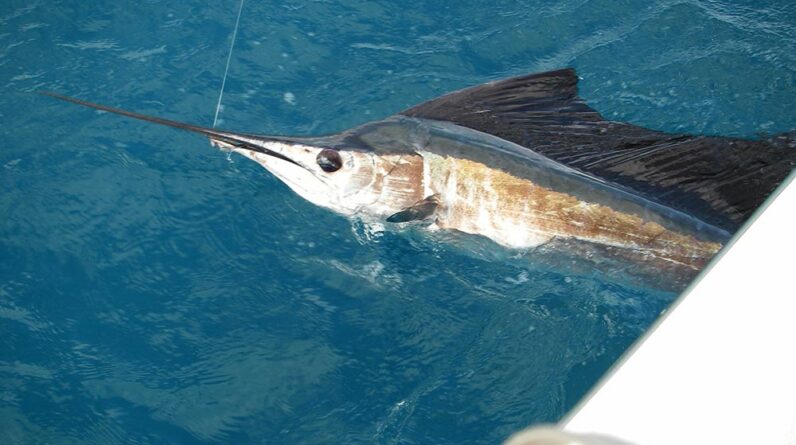Ice fishing is the best way for many Alberta fishers to fish.
Although fishing in open water can be fun too, there is something special about being on the ice in the middle of the lake with snowy mountains and trees all around you.
This piece has all the information you need to start ice fishing if you have never done it before or if you are just looking for a new winter hobby.
A few people believe that ice fishing costs a lot of money. The truth is that you can easily get everything you need to start ice fishing for less than two hundred dollars.
Some people are afraid of the cold and think that ice fishing is extremely unpleasant, which it can be if you are not well-furnished.
Intended to help you have fun while avoiding the usual mistakes first-timers make, we created this ice fishing guide.
How long does the Alberta ice fishing season last?

From the beginning of December to the end of April, based on the weather, Alberta’s ice fishing season generally lasts.
The seasons for fishing, the types of food you can use, and the number of fish you can keep vary from lake to lake in Alberta.
Prior to making travel plans, it is always smart to research the rules.
The basic rules for fishing in Alberta
An Alberta fishing license is required for all fishing in the province. These licenses cost about $28 and can be bought at Canadian Tire, some fishing shops, and online at AlbertaRELM.
If you are NOT from Canada or are visiting Alberta from another province, the card costs a little more.
A fishing ticket is required whenever you go fishing in Alberta.
People under 16 or over 65 do not need a fishing license. You still have to follow all the rules for fishing, though.
You will need to pay about $8 for an Alberta WIN (Wildlife Identification Number) card if you have never bought a fishing ticket before.
One year of fishing licenses is up at the end of March.
When it comes to rules, the major difference between open-water fishing and ice fishing is that in the winter you can use two rods for ice fishing but only one or none in the summer.
Fishing through the ice in moving water, like rivers and streams, is not allowed, though.
Once you understand the fundamentals, let us examine the tools you will need to begin ice fishing.
Things you need to start ice fishing and things that are nice to have will be separated into two groups.
Have the right gear for ice fishing
Ice fishing pole or tip-up
For fishing in open water and fishing through the ice, most people have different poles. Fishing rods for ice are generally shorter and more flexible than rods for open water.
Actually, you could use your longer summer rod for ice fishing, but it would be harder to hold it in place and tell when fish bite.
If you are on a tight budget, you can try fishing with your summer rod in the winter by taking off the reel and taping or rope-attaching it to the top of the summer rod.
Tip-ups are fishing gear that includes a reel and a line with bait on it.
The fisherman knows that the fish is biting because the reel starts to spin and an indicator, generally a flag, appears.
Utilizing minnows or smelts as bait, tip-ups are great for catching pike, burbot, and walleye.
Line for ice fishing, hooks, and a leader
A winter fishing line that doesn’t freeze and breaks less easily is what most fishers like to use, but it’s not necessary.
The type of fish you want to catch will determine the size of the line you employ.
For fishing in lakes with trout, a 6–8-pound line should be enough.
A 12-pound line is recommended for fishing for pike, burbot, and walleye.
You’ll also need a steel leader because fish-like pike can quickly cut through your line.
An Auger for Ice Fishing
To make holes in the ice, you will need a drill made for ice fishing.
There are various shapes and sizes of ice augers that you can choose from based on your fishing location and budget.
Electric, gas-powered, or hand-powered ice augers are all available.
With sharp blades and not too much ice, manual ice augers are the cheapest and smallest option.
–
For faster drilling, some people change manual augers by connecting an electric drill to them.
However, gas-powered ice augers are more expensive and heavier, but they make it much easier to drill holes, especially when fishing through the ice in early spring when it is heaviest.
When compared to gas-powered augers, electrical ones are generally more expensive but lighter and quieter.
A lot of different sizes are available for ice augers too. Regular sizes are 6, 8, and 10 inches.
A 6″ auger should work for most lakes, but if you’re pulling gigantic fish, you’ll need something bigger.
Remember that if you have a hand ice auger, a 6″ auger will be much easier to use to drill the hole in the ice than an 8″ or 10″ one.
When using larger-diameter augers, it is also easier to lose a fishing rod or drop something in the hole. That’s especially important when you’re fishing with little kids.
Not as rare as you might think, losing rods in the hole happens to everyone when they’re not paying attention (this is a sad fact from my own experience).
Lure and bait
As bait for ice fishing, nightcrawlers and jigs tipped with minnows are the most popular choices.
Whatever kind of fish you want to catch will determine the type of bait you use.
- Trout: Nightcrawlers, PowerBait, corn, shrimp, maggots, and Velveeta cheese
- Lake trout: smelts, minnows, or nightcrawlers
- Using small jigs with minnows, maggots, or nightcrawlers as a perch.
- Pinfish, Walleye, and Burbot: minnows or smelts, based on the rules
- Whitefish: Worms
While fishing at night, glow-in-the-dark jigs might help you catch more fish.
Ice fishing is usually better than summer fishing because the water isn’t as clear, so fish have to depend on smell.
Ice Scoop (Skimmer)
Since you are fishing, having some kind of scoop will make it much easier to get the ice out of the hole. This easy-to-find, low-cost tool can seriously simplify your life.
Place to hold an ice rod
Affix your fishing rod securely when ice fishing, especially if you’re after big fish that could pull your rod into the sea.
A lot of people who are just starting out tether their rod to snow, but that only works for smaller fish.
Different shapes and sizes of ice boxes are available.
Higher-tech ones have an automatic jigging system, while cheaper ones are usually just made of spiralled metal wire.
Dressing right for ice fishing
Dressing well can make your fishing trip a lot more fun. When ice fishing, you don’t want to get frostbite.
Here are some clothes that could come in handy when you go ice fishing.
- Coat Jacket
- Pair of pants
- Putting on gloves
- Sneakers made of rubber
- Ice shoes
Additionally, it is suggested that you bring a chair if you do not mind standing all day.
If I’m not going to be sitting for a long time, I like to put all of my gear on a chair to keep it dry, especially when I’m fishing without an ice fishing tent or sled.
Alternatively, you could bring a bucket that you can sit on.
It is nice to have ice fishing gear.
A sled for ice fishing
Due to thin ice or difficult access, you may not be able to drive straight to the fishing spot. In this case, you will need to carry all of your fishing gear, which is where the sled could come in handy.
A hut or tent for ice fishing
An ice fishing shelter can make your trip much more fun when it’s very cold and windy.
Depending on your wants and budget, ice fishing tents come in a variety of shapes and sizes.
Also, to keep the tent warm, you might want to get a heater.
Using Sonar for Ice Fishing (Flasher)
Deeper PRO+ Smart Sonar Castable and Portable WiFi Fish Finder with Gp…
$189.98 ($189.98 \/ kg)
You usually can’t see what’s going on underwater when you’re fishing through the ice. That’s when a light comes in handy, especially if it’s your first time fishing on a new lake.
You can also visually track the fish as it comes closer to your bait, which can help you hook it.
Southern Alberta’s best places to fish through the ice
–
These places are great if you live near Calgary, Red Deer, or Lethbridge:
- Fish in Chain Lakes Reservoir include rainbow trout and suckers
- Lake trout and whitefish can be found in Spray Lakes Reservoir.
- Pike and walleye can be found in Eagle Lake.
- Fish in Crawling Valley Reservoir include pike, burbot, walleye, and perch.
- Fish for pike in Dalemead Lake
- Fish in Pine Coulee Reservoir include pike, walleye, and rainbow trout
- There are rainbow, bull, and cutthroat trout in Upper and Lower Kananaskis Lakes.
- Fisheries in McGregor Reservoir include whitefish, pike, walleye, and burbot.
- Fisheries in Travers Reservoir include whitefish, burbot, pike, and walleye.
- Sylvan Lake has whitefish, burbot, walleye, and pike.
- Fish in Lake Newell include walleye, pike, whitefish, and burbot.
- There are pike in Twin Valley Reservoir.
- Pike in Clear Lake
Fishing safely on the ice
–
Check the ice for safety before you walk or drive on a frozen lake.
- Ice less than 4 inches thick is dangerous.
- 4 inches—Feeling safe walking on ice
- 12”—Ice is safe for small cars to drive on
- 15″ Driving a big car or truck on ice is safe
Always watch what other fishermen are doing if you’re new to a lake.
The thickness of the ice may be lessened in some places by underground currents in some lakes. Especially watch out near inlets.
Do not speed when driving on the ice, and leave one or two windows slightly open in case the car breaks through the ice.
Waves that hit the ice from driving too fast can damage it.







































